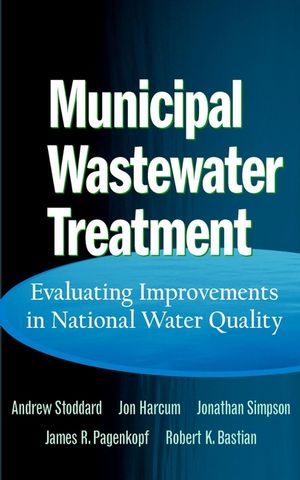Municipal Wastewater Treatment: Evaluating Improvements in National Water QualityISBN: 978-0-471-24360-1
Hardcover
672 pages
August 2002
 This is a Print-on-Demand title. It will be printed specifically to fill your order. Please allow an additional 10-15 days delivery time. The book is not returnable.
|
||||||
A thorough analysis of public policy and the Clean Water Act'seffect on water quality in the U.S.
Using water quality data and historical records from the past 60years, this book presents the measured impact of the 1972 CleanWater Act on domestic waterways-ecologically, politically, andeconomically. Municipal Wastewater Treatment supports thehypothesis that the Act's regulation of wastewater treatmentprocesses at publicly owned treatment works (POTW) and industrialfacilities has achieved significant success. The authors' case ispresented in:
* Background information on the history of water pollution controland water quality management
* Chapters addressing long-term trends in biochemical oxygen demandloadings from municipal wastewater plants and the "worst-case"dissolved oxygen levels in waterways downstream of point sourcesbefore and after the Clean Water Act
* Nine case study assessments of long-term trends of pollutantloading water quality and environmental resources associated withPOTW discharges
Using long-term trends in dissolved oxygen as the key indicator ofwater quality improvements, this book provides a detailedretrospective analysis of the effectiveness of the water pollutioncontrol policies and regulations of the 1972 Clean Water Act. Thesuccesses of the Act that have been achieved over the past 30 yearsare placed in the historical context of the "Great SanitaryAwakening" of the 19th century and changes in public policies forwater supply and water pollution control that have evolved duringthe 20th century to protect public health and the intrinsic valueof aquatic resources. Case study sites include the ConnecticutRiver, Hudson-Raritan Estuary, Delaware Estuary, Potomac Estuary,Upper Chattahoochee River, Ohio River, Upper Mississippi River, andWillamette River.
Complete with end-of-chapter summaries and conclusions, MunicipalWastewater Treatment: Evaluating Improvements in National WaterQuality is an essential book for engineers, scientists, regulators,and consultants involved in water quality management and wastewatertreatment, as well as students of environmental engineering,environmental science, and public policy.
Using water quality data and historical records from the past 60years, this book presents the measured impact of the 1972 CleanWater Act on domestic waterways-ecologically, politically, andeconomically. Municipal Wastewater Treatment supports thehypothesis that the Act's regulation of wastewater treatmentprocesses at publicly owned treatment works (POTW) and industrialfacilities has achieved significant success. The authors' case ispresented in:
* Background information on the history of water pollution controland water quality management
* Chapters addressing long-term trends in biochemical oxygen demandloadings from municipal wastewater plants and the "worst-case"dissolved oxygen levels in waterways downstream of point sourcesbefore and after the Clean Water Act
* Nine case study assessments of long-term trends of pollutantloading water quality and environmental resources associated withPOTW discharges
Using long-term trends in dissolved oxygen as the key indicator ofwater quality improvements, this book provides a detailedretrospective analysis of the effectiveness of the water pollutioncontrol policies and regulations of the 1972 Clean Water Act. Thesuccesses of the Act that have been achieved over the past 30 yearsare placed in the historical context of the "Great SanitaryAwakening" of the 19th century and changes in public policies forwater supply and water pollution control that have evolved duringthe 20th century to protect public health and the intrinsic valueof aquatic resources. Case study sites include the ConnecticutRiver, Hudson-Raritan Estuary, Delaware Estuary, Potomac Estuary,Upper Chattahoochee River, Ohio River, Upper Mississippi River, andWillamette River.
Complete with end-of-chapter summaries and conclusions, MunicipalWastewater Treatment: Evaluating Improvements in National WaterQuality is an essential book for engineers, scientists, regulators,and consultants involved in water quality management and wastewatertreatment, as well as students of environmental engineering,environmental science, and public policy.



